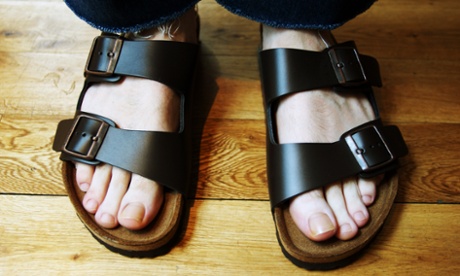
If the average British woman wears a clothing size 16, her feet will be wearing a size six – an increase by two sizes since the 70s, according to a study by the College of Podiatry last month. Of course, she may well have squeezed them into a dinkier five. In the same study, more than a third of men, and half of women, admitted to wearing shoes that weren’t the right fit. Wearing a smaller shoe – like a smaller dress size – is the latest body image issue to hit since vanity sizing.
People are getting bigger with the rise of obesity, and their feet are too. Lorraine Jones, a podiatrist at Chiswick Feet and spokeswoman for the College of Podiatry, says: “it’s not just hips and bums, there will be fat in your feet as well.” She has seen, however, a resistance in younger clients to address this: “they won’t wear shoes larger than a six even though they need to.”
Although there may be a stigma for women around having larger feet – small and dainty are the ideal – Jones believes part of the problem comes down to the variety now available on the high street, and how your size may change from shop to shop. “We buy shoes from all over the world now,” she says. “It was once a size six from Clarks and you didn’t have any choice. I always say to patients that the size is only a guide.”
The change in feet has started to be addressed by brands – particularly when it comes to width. Once a regular part of buying a pair of shoes, width measurement shows signs of returning. Jones says that online retailers tend to make their shoes slightly wider because then customers are less likely to return them. Shops including Marks & Spencer address this market – with 25% of their styles coming in wider fits. “We pride ourselves on the breadth and variety, understanding that for our customer one size does not fit all,” says Karen Peacock, head of design for footwear and accessories.
Perhaps the biggest sign that the demand is increasing comes from New Look – the trends-focused retailer which has focused in on the wide fit as an untapped market. “In September we introduced a wide fit specific team to really focus in on what this customer requires and react accordingly,” says Rob McKenna, head of footwear merchandising. “As a result, we saw a huge sales uplift for spring and we are building on this for the new season. Just because you have a slightly wider foot it doesn’t mean you don’t want to wear the latest styles.”
While McKenna says the average size sold at New Look is a six, the wider fit styles are popular in sizes eight and nine, suggesting there is a demographic who have much bigger feet than they used to admit to. This is also true at the higher end of the market. Charlotte Dellal, the designer behind brand Charlotte Olympia, says she has small but consistent demand for “up to a 42”, a UK size eight, and her shoes now go up to these larger sizes. Dellal, who has wide feet herself, makes shoes to accommodate these changes – and glamorous ones too. “I design shoes that flatter that, not cut too low,” she says. “They should look good at any size.”
Although Dellal is yet to offer the service herself, she points to bespoke as a growth area. “It used to be that people could have shoes made for their width and length of their shoes,” she says, suggesting that mass market footwear has had an impact on the state of our feet now. Ferragamo, the Italian footwear brand that once made shoes for Marilyn Monroe, still provides this service, although only for men – its Tramezza collection can be made to order. For women, Jones recommends Sargasso shoes, a small British company that creates bespoke heels for wider feet.
Back on the high street, where most women are buying shoes, the clothing side of the business could inspire another solution. Retailers could size up shoes so sizes five and six – the equivalent of an eight-10 in clothing, perhaps – are cut generously to accommodate our new bigger and wider feet. However they get there, Jones believes women wearing shoes that fit their feet is the most important thing. “I’m all for retailers saying a size seven is a size six,” she says. “If it means people are wearing the shoes that fit, that’s great.”

